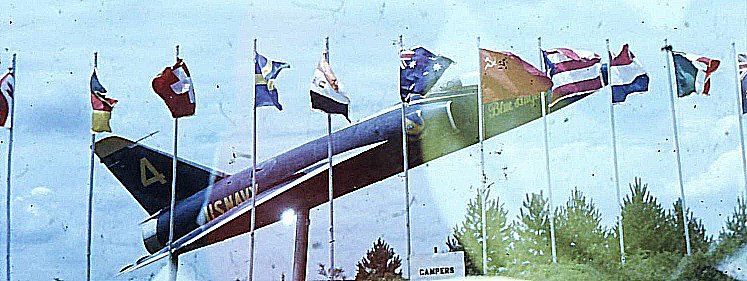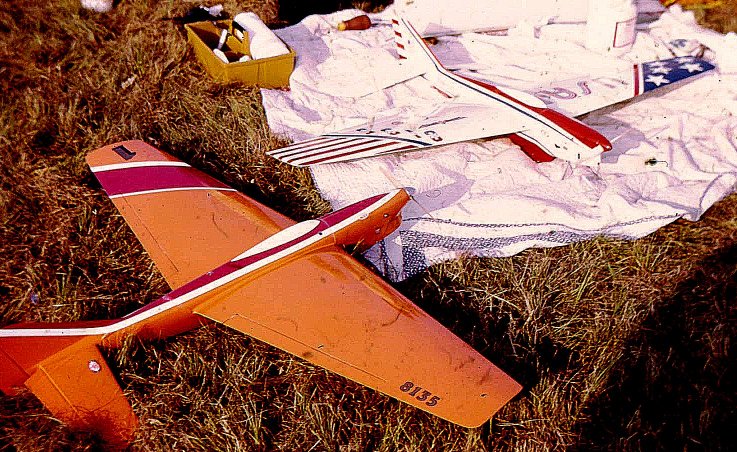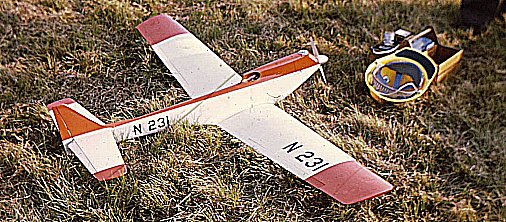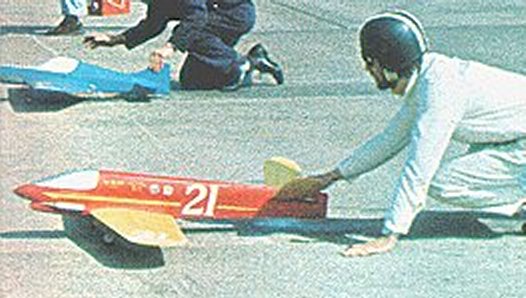
Lakehurst Gate Guardian
The '74 Aerolympics - part 1
The whole trip, organised by Ron Moulton, cost each of us £125. This was exactly the same amount that I had paid as 'key money' for my Watford flat just three months earlier. It was a lot of money at that time, but there were plenty of takers, forty two in all. On the appointed day, Mick Wilshere took me to London Airport and the whole company assembled in the departure lounge. The party looked like an awful lot of people but it was only about 10% of the full passenger list for a Jumbo. PanAm had agreed to take our model boxes free of charge and the sum included all transport and food and lodging on the site - Lakehurst airbase. I must admit that I was almost as enthusiastic about seeing the site of the Hindenburg's demise as I was about the contest.
We flew out on Sunday 30th June. My main memory is of an overdose of coffee and peanuts. The trip itself was uneventful (the film was 'Supercops'), but the approach to Kennedy airport included a steeply banked turn over the bay onto the end of the runway, with a yacht passing by a wingtip. I'd love to know what the occupants of the yacht thought and whether this was a regular occurance!

Lakehurst Gate Guardian
Two years earlier, in 1972, there had been a pylon race meeting at Doylestown. A fellow Larks club member, John Bickerstaff, had told me of his dismay on arrival. After thinking. "There's a bloody big radiator on this bus", he stepped away from it to find that the conditions were "Like being smacked in the face with a hot, wet towel".
So, our journey went from a decidedly chilly London (well, it was nearly July) via air-conditioned Jumbo, to air-conditioned Kennedy (I won't dwell on 'Immigration') and thence by air-conditioned bus to Lakehurst. At about 5 pm, New Jersey time, (10 pm body time) we emerged from the bus outside a hangar. My first thought was, "There's a bloody big..." Is there such a thing as second-hand Deja Vu?
The headquarters and processing were in one of the two small hangars alongside that massive edifice built to accomodate the 'Hindenburg' and 'Graf Zepplin'. The size of this is such that it looks to be exactly the same whether you are standing next to it or on the opposite side of the base. Driving towards it is an interesting experience. Sad to say, the doors appeared to be rusted in the open position and the hanger was used as a covered parking area for numerous full-size aircraft.

Hindenburg hanger. The two smaller hangers are larger than Cardington!
Our billets were wooden huts located on the base. These had no air-conditioning and had mesh covers over the windows and screen doors. So, all those Saturday morning films were true. The noise of 'things' pinging off the window screens all night were most disturbing. The gloworms did help to compensate a little, though. The temperature was in the 90's (degrees F) most of the time (but see below) and reached 105 in the shade on one day. Curiously, we all managed to cope with these temperatures reasonably well, apart from a reluctance to sleep. They did my damaged back a power of good and I heard no more from it for the whole 9 days of our stay.
The party had split into various groups. One such comprised of myself, Tom Jolley, Maurice Barker and Dave Handley (generally known as 'the B team'). We immediately travelled into Lakehurst itself and hired a car. This was a 2.8 litre air-conditioned Chevrolet Impala. The air-conditioning was essential - and a life-saver - but the engine size was meaningless because it was gutless. Naturally, it had automatic transmission. You could put it into first gear and wind the engine up with one foot on the brake. The car would lean right over and give an impression of enormous power, until you took your foot off the brake - nothing! There was a pleasant surprise when we came to buy fuel. It cost about £2 to fill the tank - and we only did that once.
We had brought with us Tom's electric starter based on a Honda (motorbike) starter motor and managed to hire a fully charged car (er, auto) battery from the garage that we hired the car from. We had various different means of lighting glow plugs. Mine consisted of a pair of nicads in a box - at that time a very unusual arrangement.
I had just one practice flight on the Tuesday with FM 5. We had to take the decision to limit practice because we were all on 27 Mhz and were told by the locals that this was impossible and that we couldn't survive - the locals were on 72 Mhz. As usual, claims of interference by Citizens Band radio were wildly pessimistic. Certainly, the available monitors showed speech on all channels, but it was low strength and only about 30% modulation. Nothing that could affect a short range 100% modulation R/C signal. I don't believe that anyone experienced even a serious glitch. I had actually taken a World Engines 72 Mhz set with me but was reluctant to use it because I hadn't test flown it.
All of the european models showed signs of being overcompressed and we all added head shims to our motors. I'm still not convinced that this was actually necessary. In my own case, I was 7 - 10 seconds slower than I would have expected at home without the shims. I decided to leave my HP 40 in FM 4 alone, since it worked well in the UK. I added shims to the K&B 40S in FM 5 as this was still a relatively unknown quantity anyway.
It soon became clear that this was the motor to have, since it was the one used by the Violet/Telford team. I was the only one of the visitors who had such a motor, yes, the one that had been sitting in a box for almost two years! I talked to Cliff Telford and learned that the motor was considered to be at its best straight out of the box. I did actually see them take a motor out of the box, fit it to the model, give it a short test run and then win a heat with a very good time. At that rate, mine was clearly way over the hill as it had at least 5 flights on it.

Telford/Violett's two 'Bobcat' models. The white/red/blue model was used just once.
Racing started on Wednesday, at which point we were not really sure which day it was. My diary entries at the time were all a day early and had to be corrected later. We were fortunate in that the pylon event didn't start until 8 pm local time when it was cooler. We were not so fortunate in that we missed the evening meal that we had paid for and had to travel into town each night to eat.
Things didn't start well for me. The bad news was that I was drawn to fly against Telford/Violet in my first heat and I was last (1 point) in a time of 2:04. In the second heat, just after take-off my model was overflown and hit by one of the American entries (Adam Sattler), forcing me into the ground and breaking the prop. No time and no points. The American CD refused to acknowledge the collision and allowed the other model to continue and finish second. The rules said that models involved in a collision must land immediately and would be given a chance to refly. There were several other collisions, but I can find no evidence of any reflights. My third heat of the evening resulted in second place (3 points) in 1:58. So far, I had 4 points from a possible 12.

Adam Satler's strikingly semi-scale model. It bore clear marks of contact.
Thursday evening had just one race for me and I again finished second (3 points) in 1:54 (my fastest time). It was becoming clear that there was a considerable disparity in the timing. Models which finshed close to each other on the same lap were given vastly different times. I don't believe that this was partisanship, merely variation in timekeepers thumbs.
Friday was to produce a big change. Shortly before racing was to start, the temperature dropped sharply to a mere 70 degrees or so. A local warned that there would be a thunderstorm in half an hour. This didn't seem likely as there was bright evening sunshine and a clear blue sky. However, it was true and there followed the most dramatic storm that I have seen. At one point, the course pylons were blowing along the runway like land yachts. There was something like 3 inches of rain in a little over an hour and the wind was so strong that it was possible to remain completely dry by standing in the lee of a vehicle. Ask me how I know. There was simply no way to dismantle a model and stow it away so I had to shelter while hanging on to it grimly.

Not fog.
After all this, there was relative calm, the runway dried in about half an hour and I actually flew in two heats. The reason I had a model assembled when the storm started was because I had decided to run the motor in my other model, FM 4, in the much cooler conditions. This had my hitherto successful HP 40 which had not been used because it didn't seem happy in the frying temperatures (although it was probably the humidity which it didn't like). The run was totally inconclusive, a fact which Tom Jolley didn't want to believe. Relations were a little strained for a while. Nonetheless, I flew FM 4 and got another second (3 points) in !:59. I flew FM 5 in the second heat and got yet another second in 1:58.
I flew two more heats on Saturday (making eight in all), both with FM 5 and got another second in 1:57 and - at last - a win (4 points) in I:59. In the first of these, the winner was given 1:42, which was then changed to 1:46. I was never more than about 30 yards behind him!
I ended up with 20 points from a possible 32 and 14th place. That zero cost me dearly and I could easily have been 8th or 9th. In local parlance, I could have won eighth place.
To those of us on our first visit to the US of A, the food was a revelation. Vast quantities at very cheap prices. On one evening, Maurice Barker announced that he was just going to settle for chicken and chips, nothing else. This was just as well, because all four of us could have eaten our fill on his order. A whole chicken and a bucket of chips just about covered it.
I have other thoughts on the weather, but New Jersey in July was never going to be balmy.
When I came to write this, I found that my 1974 diary had a full list of heats and results (but no times unfortunately). This enabled me to work out the full list of finishing positions, which appears below. Heats consisted of four flyers and the scoring was based on 4 points for first place, 3 for second, 2 for third and 1 for fourth. A zero means that the model didn't complete 10 laps, which could be for any reason from a failure to start the engine to 2 or more cut pylons. There was only one case of a 'no show', which is highly commendable.
The rules at the time were specific that the finishing positions were dependent on time, but it was clear that positions were being decided on the local system of 'first across the line' and there were several examples of the second placed model having a faster time than the winner. Personally, I can't argue with this and feel that it was just as well that the times weren't published.
The pylon racing contest (what a fascinating name? Did you ever see anyone race a pylon?) was an open international event, having provisional status and provisional rules. Thus, there were numerous entries from the UK and USA. Attempts were being made to have the event raised to world championship status, but this was to take many more years.
| Place | Name | Country | Heat 1 | Heat 2 | Heat3 | Heat4 | Heat5 | Heat6 | Heat 7 | Heat 8 | Total |
|---|---|---|---|---|---|---|---|---|---|---|---|
| 1 | Telford/Violet | USA | 4 | 4 | 4 | 4 | 4 | 4 | 4 | 4 | 32 |
| 2 | Booker | 4 | 3 | 4 | 4 | 4 | 4 | 2 | 4 | 29 | |
| 3 | Helsel | 3 | 4 | 4 | 4 | 2 | 4 | 4 | 4 | 29 | |
| 4 | Wall | GB | 4 | 4 | 4 | 4 | 4 | 4 | 0 | 4 | 28 |
| 5 | Wagner | 4 | 4 | 4 | 3 | 4 | 4 | 0 | 2 | 25 | |
| 6 | Beaumont | GB | 3 | 4 | 4 | 0 | 1 | 4 | 4 | 4 | 24 |
| 7 | DeBolt | USA | 4 | 4 | 3 | 0 | 4 | 3 | 4 | 2 | 24 |
| 8 | Karlsson | 0 | 4 | 3 | 0 | 4 | 4 | 4 | 4 | 23 | |
| 9 | Brouquires | FR | 4 | 3 | 2 | 2 | 3 | 3 | 4 | 2 | 23 |
| 10 | Sattler | 3 | 3 | 4 | 0 | 4 | 4 | 3 | 0 | 21 | |
| 11 | Ruesch | 4 | 2 | 2 | 3 | 2 | 2 | 3 | 3 | 21 | |
| 12 | Greeno | GB | 4 | 0 | 0 | 4 | 4 | 3 | 2 | 3 | 20 |
| 13 | Davis | 2 | 4 | 2 | 3 | 3 | 2 | 4 | 0 | 20 | |
| 14 | Day | GB | 1 | 0 | 3 | 3 | 3 | 3 | 3 | 4 | 20 |
| 15 | Jolley | GB | 2 | 4 | 2 | 4 | 3 | 0 | 2 | 4 | 19 |
| 16 | Svenningson | 0 | 3 | 3 | 2 | 4 | 3 | 4 | 0 | 19 | |
| 17 | Nicholls | GB | 3 | 0 | 3 | 4 | 4 | 2 | 0 | 3 | 19 |
| 18 | Laurie | GB | 1 | 3 | 4 | 2 | 0 | 3 | 4 | 2 | 19 |
| 19 | Baitzar | 4 | 3 | 1 | 3 | 3 | 2 | 3 | 0 | 19 | |
| 20 | Zautner | 4 | 0 | 4 | 4 | 0 | 0 | 3 | 3 | 18 | |
| 21 | Lehtinen | 0 | 4 | 2 | 4 | 2 | 0 | 2 | 3 | 17 | |
| 22 | Guisinger | 1 | 3 | 4 | 0 | 3 | 3 | 0 | 3 | 17 | |
| 23 | Bannister | GB | 0 | 3 | 0 | 3 | 3 | 0 | 3 | 4 | 16 |
| 24 | Barker | GB | 0 | 1 | 3 | 3 | 0 | 3 | 2 | 4 | 16 |
| 25 | Reed | 0 | 4 | 3 | 2 | 1 | 3 | 1 | 2 | 16 | |
| 26 | Tappin | GB | 3 | 0 | 3 | 0 | 3 | 4 | 2 | 0 | 15 |
| 27 | Barkowski | 0 | 2 | 3 | - | 4 | 0 | 3 | 3 | 15 | |
| 28 | Johnson | 3 | 2 | 2 | 0 | 2 | 2 | 3 | 1 | 15 | |
| 29 | Sederholm | 0 | 2 | 1 | 2 | 3 | 1 | 2 | 3 | 14 | |
| 30 | Derrough | 3 | 3 | 0 | 0 | 2 | 2 | 3 | 0 | 13 | |
| 31 | Handley | GB | 2 | 3 | 1 | 0 | 0 | 3 | 0 | 3 | 12 |
| 32 | Dowdeswell | GB | 0 | 0 | 0 | 3 | 2 | 1 | 4 | 1 | 11 |
| 33 | Crawford | 3 | 2 | 2 | 0 | 3 | 0 | 1 | 1 | 11 | |
| 34 | Reinas | 2 | 2 | 1 | 1 | 2 | 2 | 0 | 0 | 10 | |
| 33 | Noll | 3 | 0 | 0 | 0 | 0 | 4 | 2 | 0 | 9 | |
| 36 | Rawcliffe | GB | 2 | 0 | 2 | 2 | 0 | 0 | 1 | 2 | 9 |
| 37 | Lundin | 2 | 0 | 0 | 0 | 0 | 0 | 0 | 2 | 4 | |
| 38 | Frankham | GB | 0 | 0 | 0 | 0 | 0 | 0 | 0 | 0 | 0 |

FAIr Move 5 at the '75 Nationals with caller Garry Pope.
'RCM&E' cover shot.